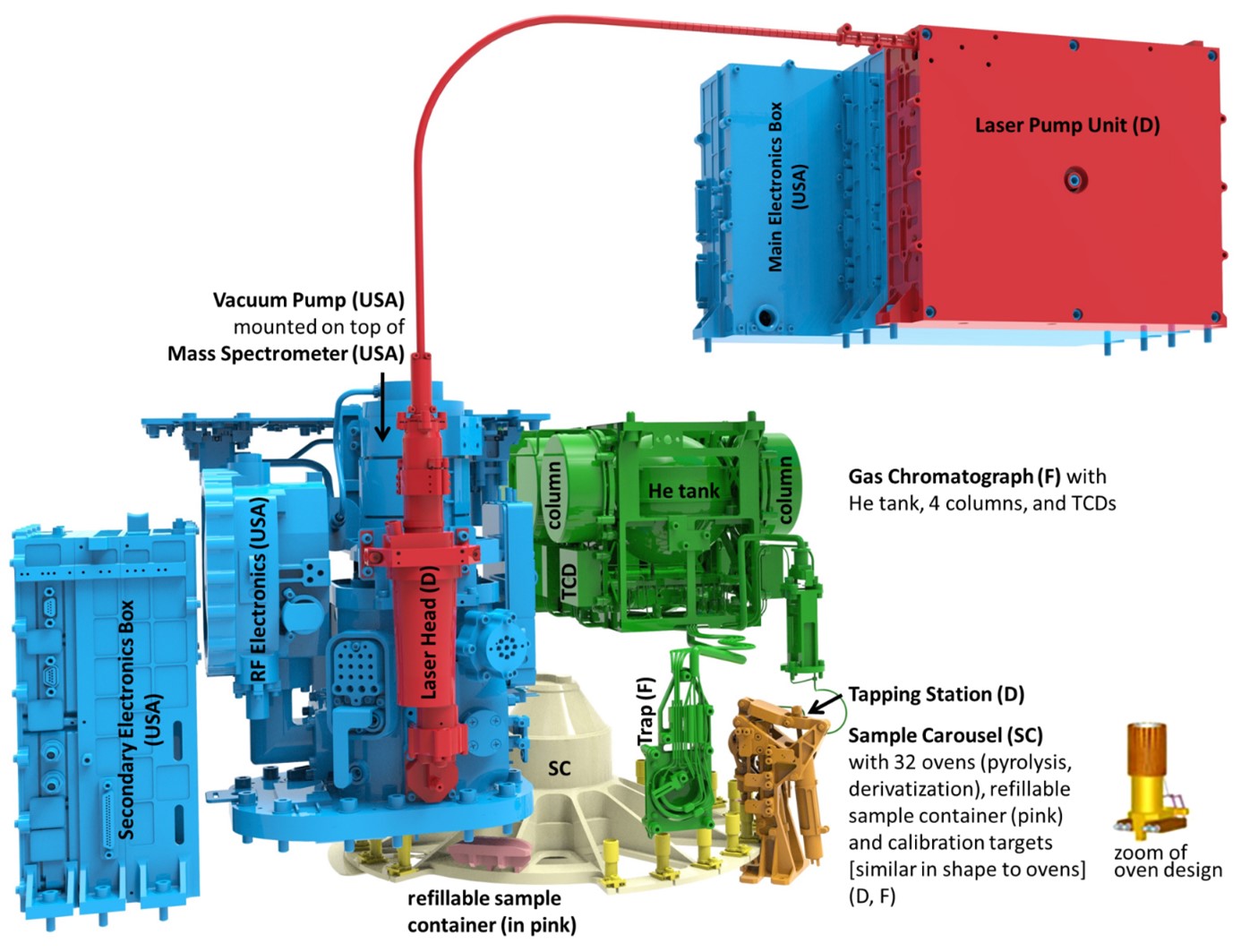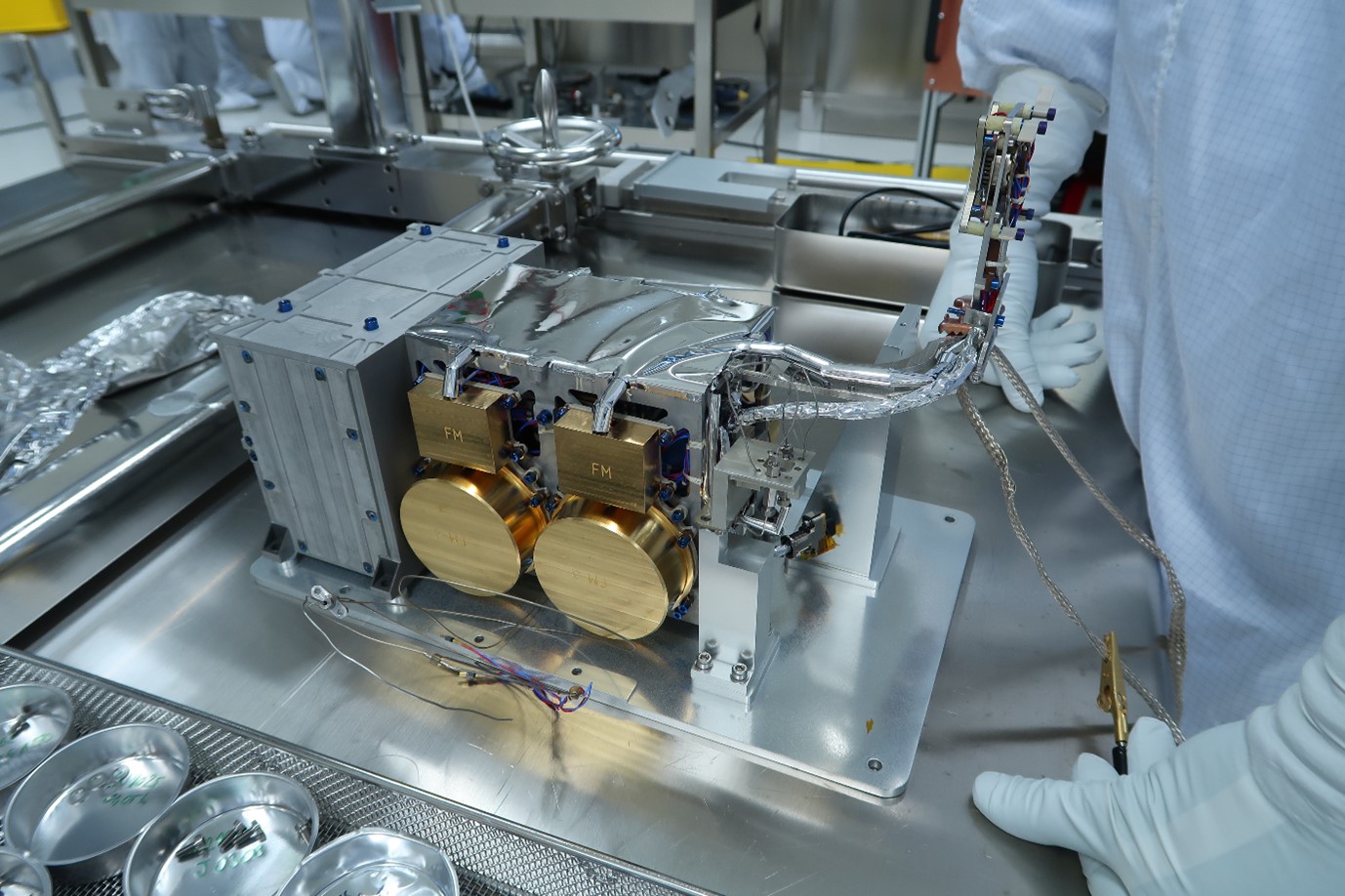MOMA-GC
MOMA GC (Mars Organic Molecule Analyser)
Contact LISA : F. Stalport (This email address is being protected from spambots. You need JavaScript enabled to view it. This email address is being protected from spambots. You need JavaScript enabled to view it. )
PI: F. Stalport
Objectives: Detection of organic matter in situ as part of the Exomars Rosalind Franklin Mars Exploration Mission
The Mars Organic Molecule Analyser (MOMA) is an on-board experiment on the rover of the ExoMars 2028 in situ Mars exploration mission (European Space Agency/ESA and US Space Agency/NASA). It is under the responsibility of the Max Planck Institute for Solar System Research (MPS, Goettingen, Germany). MOMA (Figure 1), which is the fruit of European and American cooperation, combines 3 complementary analytical instruments designed to provide the molecular, elemental and chiral chemical composition of the surface/sub-surface of Mars:

Figure 1: 3D view of the MOMA instrument. In red, the desorption laser (LD), in blue, the mass spectrometer (MS), in green, the gas chromatograph (GC), in orange, the tapping station, in yellow, the furnaces, in ivory, the sample carousel.
These instruments are:
i) a mass spectrometer (MS) developed by an American consortium under the responsibility of the NASA/GSFC center (Maryland, USA).
ii) a laser desorption (LD) system developed by MPS and German colleagues.
iii) a gas chromatograph (GC) developed by the Laboratoire Interuniversitaire des Systèmes Atmosphériques (LISA) in partnership with the Laboratoire Atmosphères, Milieux, Observations Spatiales (LATMOS) under the aegis of the Centre National d'Etudes Spatiales (CNES) (Figure 2).

Figure 2: Photo of the GC part of MOMA, developed at LISA
This instrument set is essentially dedicated to the detection of organic matter. If successful, the question of the biotic or abiotic origin of this matter will be addressed from the angle of molecular identification and chiral and isotopic composition. The main aim is to identify and characterize the organic molecules (carbonaceous molecules, including those necessary for life as we know it) that could be found in the soil of Mars. In addition, the new data will broaden our understanding of Mars as a whole.
The MOMA instrument is designed to analyze Martian soil and rocks using two main approaches. Firstly, the ground sample can be placed in one of the MOMA instrument's mini-furnaces, equipped with a rotating carousel. After filling, the furnace is moved to a tapping station, which hermetically seals the furnace. Heated to 850°C, the most volatile compounds are extracted from the collected sample. These volatile species are then pushed through a helium stream to the gas chromatograph (GC). After separation and potential identification by GC, the compounds enter a mass spectrometer (MS). This is the GC-MS mode of the instrument. In the case of the most refractory organic compounds, a chemical derivatization step is added during passage through the “tapping station” to increase the volatility of these compounds and facilitate their thermal extraction. One of the derivatization methods will also enable chiral separation of certain compounds such as amino acids, providing valuable information on their biological or abiotic origin.
Alternatively, a refillable sample container can be filled with ground soil sample or a piece of rock. In this case, a desorption laser (LD) is used to desorb and ionize a small area of the sample. The ions generated are then guided to the mass spectrometer for analysis. This is the LD-MS mode of the instrument.
The Exomars rover is equipped with a full suite of instruments, including the MOMA instrument and a drill that will take surface/sub-surface samples down to a depth of 2 meters, in an area where these samples will be better preserved from the extreme surface conditions of Mars.
Lift-off in 2028 for arrival on Mars in 2030!
More links :
https://www.esa.int/Science_Exploration/Human_and_Robotic_Exploration/Exploration/ExoMars
https://www.mps.mpg.de/planetary-science/exomars-moma
https://svs.gsfc.nasa.gov/13002/
Some articles/publications :
- https://theconversation.com/comment-cherche-t-on-des-traces-de-vie-sur-mars-136720
- Guzman, M ; Szopa, C ; Freissinet, C ; Buch, A ; Stalport, F ; Kaplan, D ; Raulin F: Testing the capabilities of the Mars Organic Molecule Analyser (MOMA) chromatographic columns for the separation of organic compounds on Mars (2020) PLANETARY AND SPACE SCIENCE Volume 186, article id. 104903
- Goesmann, F; Brinckerhoff, WB; Raulin, F; Goetz, W; Danell, RM; Getty, SA; Siljestrom, S; Missbach, H; Steininger, H; Arevalo, RD; Buch, A; Freissinet, C; Grubisic, A; Meierhenrich, UJ; Pinnick, VT; Stalport, F; Szopa, C; Vago, JL; Lindner, R; Schulte, MD; Brucato, JR; Glavin, DP; Grand, N; Li, X van Amerom, FHW: The Mars Organic Molecule Analyzer (MOMA) Instrument: Characterization of Organic Material in Martian Sediments (2017) ASTROBIOLOGY Volume: 17 Issue: 6-7 Pages: 655-685
- Goetz, W; Brinckerhoff, WB; Arevalo, R; Freissinet, C; Getty, S; Glavin, DP; Siljestrom, S; Buch, A; Stalport, F; Grubisic, A; Li, X; Pinnick, V; Danell, R; van Amerom, FHW; Goesmann, F; Steininger, H; Grand, N; Raulin, F; Szopa, C; Meierhenrich, U; Brucato, JR: MOMA: the challenge to search for organics and biosignatures on Mars (2016) INTERNATIONAL JOURNAL OF ASTROBIOLOGY Volume: 15 Issue: 3 Pages: 239-250

